

Pumpkin Garland. 3D Paper Pumpkin. Use fall or Halloween themed card stock to create a fun three dimensional pumpkin to display in your home.
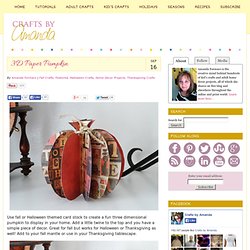
Add a little twine to the top and you have a simple piece of decor. Great for fall but works for Halloween or Thanksgiving as well! Add to your fall mantle or use in your Thanksgiving tablescape. It’s only been a few years that I’ve actually decorated for fall and Thanksgiving. Halloween is a different story, I’ve always decorated for that! These paper pumpkins are really easy to make and they look great! Cut scrapbook paper into eight 6-inch squares. Cut plain sheet of paper into a 6-inch square. Cut out the pattern. Use the pattern to cut pumpkins from each of the pieces of scrapbook paper. Fold each pumpkin in half and crease. Using the glue tape to add adhesive to the back of the paper strip, then press it onto the creases of both pumpkins, joining them together.
Crafts for Kids Blog » Tutorial : Monster Corkboard. 7Alive all Livin' in a Double Wide: Easy No-Sew Bean Bags. Building Trunk Strength. Motor play is crucial for the growing child.
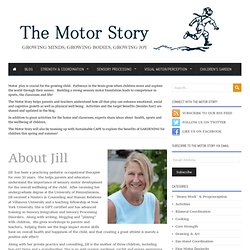
Pathways in the brain grow when children move and explore the world through their senses. Building a strong sensory motor foundation leads to competence in sports, the classroom and life! The Motor Story helps parents and teachers understand how all that play can enhance emotional, social and cognitive growth as well as physical well being. Activities and the target benefits (besides fun!) Are shared and updated in the blog. In addition to great activities for the home and classroom, experts share ideas about health, sports and the wellbeing of children. The Motor Story will also be teaming up with Sustainable CAPE to explore the benefits of GARDENING for children this spring and summer!
Jill has been a practicing pediatric occupational therapist for over 30 years. Along with her private practice and consulting, Jill is the mother of three children, including boy-girl twins and a grandmother. Like this: Like Loading... Gross motor skills for toddlers by Jean Warren. Helping Children Develop Gross Motor Skills. Here is a list of basic large muscle motions that can be practiced in your house or in the yard.
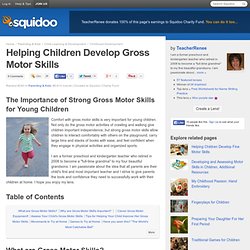
No extra equipment is needed! To make practice with these basic movements more fun, try playing a “copy cat” game. Demonstrate the skill to your child and ask him to copy your movements. Or turn on some lively music to keep the practice more interesting. The movements are listed in increasing difficulty. Resources - Guest Blog: Learn to Move It, Move It - featured September 9, 2010. Learn To Move It, Move It By: Dr.
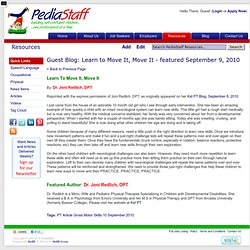
Joni Redlich, DPT Reprinted with the express permission of Joni Redlich, DPT, as originally appeared on her Kid PT Blog, September 8, 2010 I just came from the house of an adorable 10 month old girl who I see through early intervention. She has been an amazing example of how quickly a child with an intact neurological system can learn new skills. Some children because of many different reasons, need a little push in the right direction to learn new skills.
On the other hand children with neurological challenges can also learn. Featured Author: Dr. Dr. Resources - Guest Blog: Trunk Strengthening for Kids - featured December 9, 2011. Guest Blog: Trunk Strengthening for Kids By: Dr.
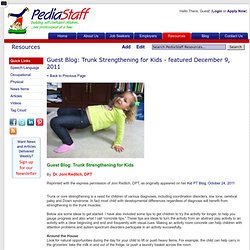
Joni Redlich, DPT Reprinted with the express permission of Joni Redlich, DPT, as originally appeared on her Kid PT Blog, October 24, 2011 Trunk or core strengthening is a need for children of various diagnoses, including coordination disorders, low tone, cerebral palsy and Down syndrome. In fact most child with developmental differences regardless of diagnosis will benefit from strengthening to the trunk muscles. Resources - Gross Motor Development and Down Syndrome - featured August 13, 2010. Gross Motor Development and Down Syndrome All material Copyright © 2009 National Down Syndrome Society Reprinted with the express permission of the National Down Syndrome Society as originally published on their Website.

By: Patricia C. Winders, PT Senior Physical Therapist, Down Syndrome Specialist Sie Center for Down Syndrome The Children's Hospital, Aurora, CO NB: This article was originally written for parents but contains excellent information for therapists and so we reprint it here. Resources - Guest Blog: Animal Shapes to Encourage Gross Motor Skills - featured December 9, 2010. Guest Blog: Animal Shapes to Encourage Gross Motor Skills All material Copyright © November 2010 The Down Syndrome Centre Reprinted with the express permission of the Down Syndrome Centre as originally published on their website.
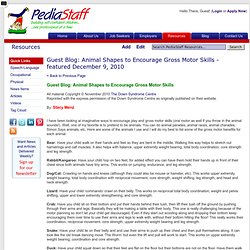
By: Stacy Menz I have been looking at imaginative ways to encourage play and gross motor skills (oral motor as well if you throw in the animal sounds!). Well, one of my favorite is to pretend to be animals. Resources - The Importance of Generalization of Skills - July 2009. The Importance of Generalization of Skills By: Christina Whalen, PhD, BCBA and Manya Vaupel, MA, BCBA Jigsaw Learning Printed here with express permission of Christina Whalen.
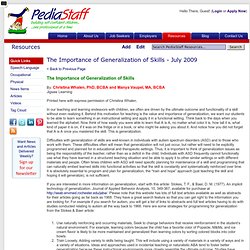
In our teaching and learning endeavors with children, we often are driven by the ultimate outcome and functionality of a skill without even realizing it. Behind this motivation for teaching is the value and importance of generalization, we want our students to be able to learn something in an instructional setting and apply it in a functional setting.
Think back to the days when you learned the alphabet. Difficulties with generalization of skills are well-known in individuals with autism spectrum disorders (ASD) and to those who work with them. If you are interested in more information on generalization, start with this article: Stokes, T. Use naturally reinforcing and occurring materials, Seek to change behaviors that receive reinforcement in the student’s natural environment. Resources - Eye Hand Coordination and Motor Control Activity for Children, Tip or Resources of Week. Resources - Guest Blog: Every Motor Event is a Sensory Event First - featured June 8, 2011. Every Motor Event is a Sensory Event First All material Copyright © November 2010 HeartSpace Blog Reprinted with the express permission of the the author and the HeartSpace Blog as originally published on their website.
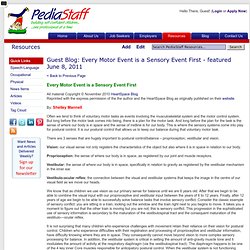
By: Shelley Mannell Often we tend to think of voluntary motor tasks as events involving the musculoskeletal system and the motor control system. But long before the motor task comes into being, there is a plan for the motor task. And long before the plan for the task is the sense of where our body is in space and the sense of midline is for our body. There are 3 senses that are hugely important to postural control/balance – proprioception, vestibular and vision.
Vision: our visual sense not only registers the characteristics of the object but also where it is in space in relation to our body.